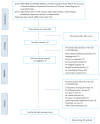Clinical Outcomes and Complications of Cortical Button Distal Biceps Repair: A Systematic Review of the Literature
- PMID: 27525303
- PMCID: PMC4972921
- DOI: 10.1155/2016/3498403
Clinical Outcomes and Complications of Cortical Button Distal Biceps Repair: A Systematic Review of the Literature
Abstract
Objectives. The purpose of the present study was to investigate the clinical outcomes and complications of the cortical button distal biceps fixation method. Material and Methods. All methods followed the PRISMA guidelines. Included studies had to describe clinical outcomes and complications after acute distal biceps repair with cortical button fixation. Eligibility criteria also included English language, more than 5 cases with minimum follow-up of 6 months, and preferably usage of at least one relevant clinical score (MEPS, ASES, and/or DASH) for final outcome. A loss of at least 30° in motion-flexion, extension, pronation, or supination-and a loss of at least 30% of strength were considered an unsatisfactory result. Results. The review identified 7 articles including 105 patients (mean age 43.6 years) with 106 acute distal biceps ruptures. Mean follow-up was 26.3 months. Functional outcome of ROM regarding flexion/extension and pronation/supination was satisfactory in 94 (89.5%) and 86 (82%) patients in respect. Averaged flexion and supination strength had been reported in 6/7 studies (97 patients) and were satisfactory in 82.4% of them. The most common complication was transient nerve palsy (14.2%). The overall reoperation rate was 4.8% (5/105 cases). Conclusion. Cortical button fixation for acute distal biceps repair is a reproducible operation with good clinical results. Most of the complications can be avoided with appropriate surgical technique.
Figures
References
-
- Safran M. R., Graham S. M. Distal biceps tendon ruptures: incidence, demographics, and the effect of smoking. Clinical Orthopaedics and Related Research. 2002;(404):275–283. - PubMed
-
- Savvidou C., Moreno R. Spontaneous distal biceps tendon ruptures: are they related to statin administration? Hand Surgery. 2012;17(2):167–171. - PubMed
-
- Baker B. E., Bierwagen D. Rupture of the distal tendon of the biceps brachii. Operative versus non-operative treatment. Journal of Bone and Joint Surgery A. 1985;67(3):414–417. - PubMed
-
- Rantanen J., Orava S. Rupture of the distal biceps tendon: a report of 19 patients treated with anatomic reinsertion, and a meta-analysis of 147 cases found in the literature. The American Journal of Sports Medicine. 1999;27(2):128–132. - PubMed
-
- Citak M., Backhaus M., Seybold D., Suero E. M., Schildhauer T. A., Roetman B. Surgical repair of the distal biceps brachii tendon: a comparative study of three surgical fixation techniques. Knee Surgery, Sports Traumatology, Arthroscopy. 2011;19(11):1936–1941. doi: 10.1007/s00167-011-1591-0. - DOI - PubMed
Publication types
LinkOut - more resources
Full Text Sources
Other Literature Sources


